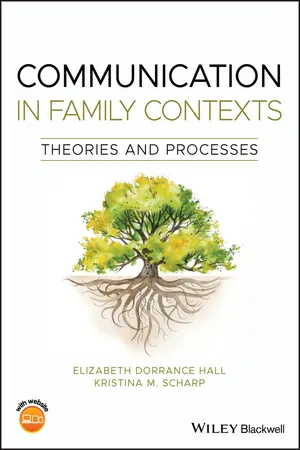
Communication in Family Contexts
Theories and Processes
- English
- ePUB (mobile friendly)
- Available on iOS & Android
About this book
An innovative, student-friendly textbook covering the major elements of the field of Family Communication
Family Communication, a rapidly growing sub-discipline within Communication Studies, explores the processes and factors involved in family interactions and relationships. Communication in Family Contexts is a clear and accessible survey of the essential principles, theories, and concepts of the field. Unlike textbooks that present a vast amount of material across only a few chapters—this innovative textbook features brief, easily-understood chapters ideally-suited for undergraduate courses on the subject.
The text provides concise yet comprehensive coverage of a diverse range of topics, from fundamental aspects of caretaking and sibling communication, to topics not covered in other textbooks such as estrangement and marginalization. 33 chapters cover theories of family communication, family communication processes, and communicating in family relationships. The authors, noted researchers and educators in the field, complement discussions of standard topics with those of growing contemporary interest, such as LGBTQ family communication, step-family and half-sibling relationships, and the influence of technology on family. This textbook:
- Provides a well-rounded examination of the major elements of Family Communication studies
- Explains the foundational theories of the field, including Family Communication Patterns Theory and Relational Dialectics Theory
- Features numerous practical application exercises to enable students apply theory to practice
- Includes a complete set pedagogical features, such as case studies, visualizations and models of theories, illustrations, and discussion questions
- Offers a flexible organizational structure that allows instructors to pick and choose chapters to meet the needs of their courses
Communication in Family Contexts: Theories and Processes is an important resource for instructors and students in the field of family communication, the wider discipline of Communication Studies, and related areas such as social psychology and sociology.
Frequently asked questions
- Essential is ideal for learners and professionals who enjoy exploring a wide range of subjects. Access the Essential Library with 800,000+ trusted titles and best-sellers across business, personal growth, and the humanities. Includes unlimited reading time and Standard Read Aloud voice.
- Complete: Perfect for advanced learners and researchers needing full, unrestricted access. Unlock 1.4M+ books across hundreds of subjects, including academic and specialized titles. The Complete Plan also includes advanced features like Premium Read Aloud and Research Assistant.
Please note we cannot support devices running on iOS 13 and Android 7 or earlier. Learn more about using the app.
Information
Chapter 1
An Introduction to Communication in Family Contexts
WHAT IS A FAMILY?
WHAT IS FAMILY COMMUNICATION?
Defining Family Communication
Intersections of Family Identity
Table of contents
- Cover
- Table of Contents
- Preface
- Meet the Authors
- Meet the Case Study Contributors
- Acknowledgments
- About the Companion Website
- Chapter 1: An Introduction to Communication in Family Contexts
- Chapter 2: Research Paradigms and Methods that Inform Family Communication Research
- Part I: Theories of Family Communication
- Part II: Family Communication Processes
- Foundational Processes
- Major Family Transitions
- Part III: Communicating in Family Relationships
- Family and Relationship Types
- Family Communication in Context
- Author Index
- Subject Index
- End User License Agreement